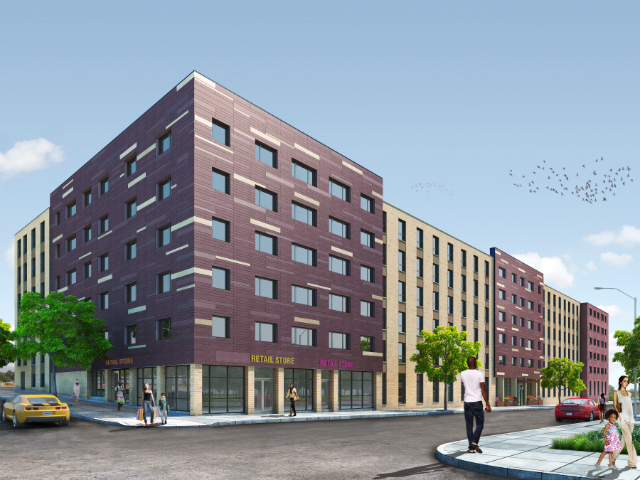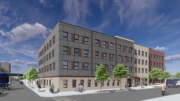Between the residential neighborhoods of Brownsville and East New York, just south of Broadway Junction, lies the East New York Industrial Business Zone (IBZ). Vacant city-owned sites, zoned exclusively for industrial and commercial uses, were sold off, with the intention of creating job opportunities within the 100-acre East New York IBZ.
The city’s Economic Development Corporation touts the success of the zone in bringing to the area “45 industrial and manufacturing businesses that provide more than 1,000 industrial and manufacturing jobs,” but the eventual fate of the land – which is mostly eaten up by parking, warehousing and wholesaling, not well-paying manufacturing – is still in flux. Chief city planner Carl Weisbrod has singled out Atlantic Avenue, for example, which forms the northern border of the IBZ, for a possible future rezoning to encourage the development of affordable housing.
And at least one residential project is going forward in the heart of the industrial zone even before the rezoning, at 91 Junius Street. There, a group called Women In Need, which provides homes and services for homeless women and children, won a variance in 2011 to build a six-story affordable and supportive housing facility called the Glenmore, at the corner of Junius and Glenmore Avenue. While the area is only zoned for medium-low density industrial and commercial use, the Board of Standards and Appeals authorized the construction of a 170,000-square foot residential building.
Designed by YIMBY regular Urban Architectural Initiatives, the building will hold 176 apartments, running the gamut from studios to three-bedroom apartments, with a mix of 105 special needs supportive units and the remainder as regular low-income affordable housing. Like UAI’s other buildings, the design is simple and attractive, with the façade segmented into lighter and darker parts and no loud, energy-wasting PTAC units intruding on the clean exterior. The project will include a 7,600-square foot park on the corner of Junius and Glenmore as well as retail space, enlivening an otherwise desolate street.
Getting the project approved was relatively easy, as it was allowed to slide through the lower-profile BSA variance process rather than the more onerous and politicized ULURP rezoning ordeal. Council members Diana Reyna (now Brooklyn’s deputy borough president) and Erik Martin Dilan opposed the variance, as did a few business groups, because of the project’s location within the East New York IBZ. While the BSA decision did not go into detail about their opposition, it was likely based on the loss of land zoned for industrial use.
Expect this to again become an issue when the Department of City Planning looks to rezone a broader swath of East New York for more affordable housing. With little in the way of market-rate development to serve as a gentrification boogeyman, any proposed rezoning will instead pit those who hope for a brighter industrial future against those looking to open up more land for residential development. Given the city has been suffering from an acute housing shortage for generations, residential use is definitely more beneficial, especially as New York continues to hemorrhage industrial and manufacturing jobs, which will never return.
While that debate rages on, the Glenmore is a done deal. Construction is set to start early next year and completion is likely by the end of 2017.
Talk about this topic on the YIMBY Forums
For any questions, comments, or feedback, email newyorkyimby@gmail.com
Subscribe to YIMBY’s daily e-mail
Follow YIMBYgram for real-time photo updates
Like YIMBY on Facebook
Follow YIMBY’s Twitter for the latest in YIMBYnews





